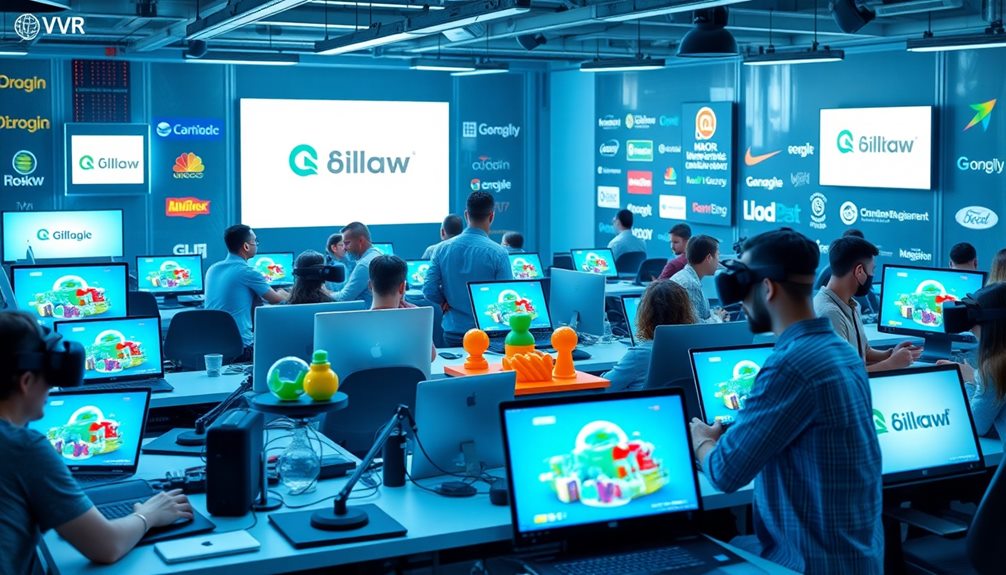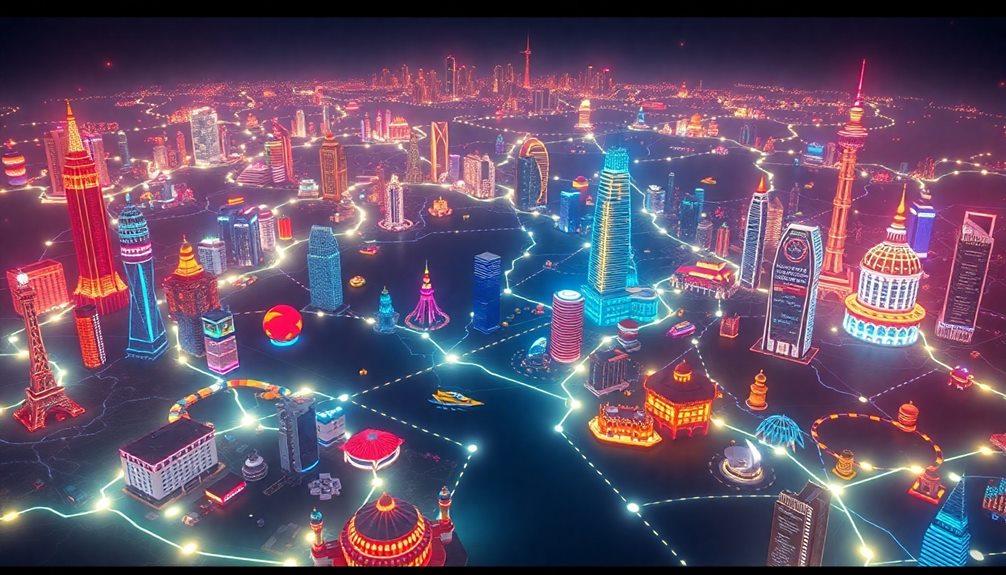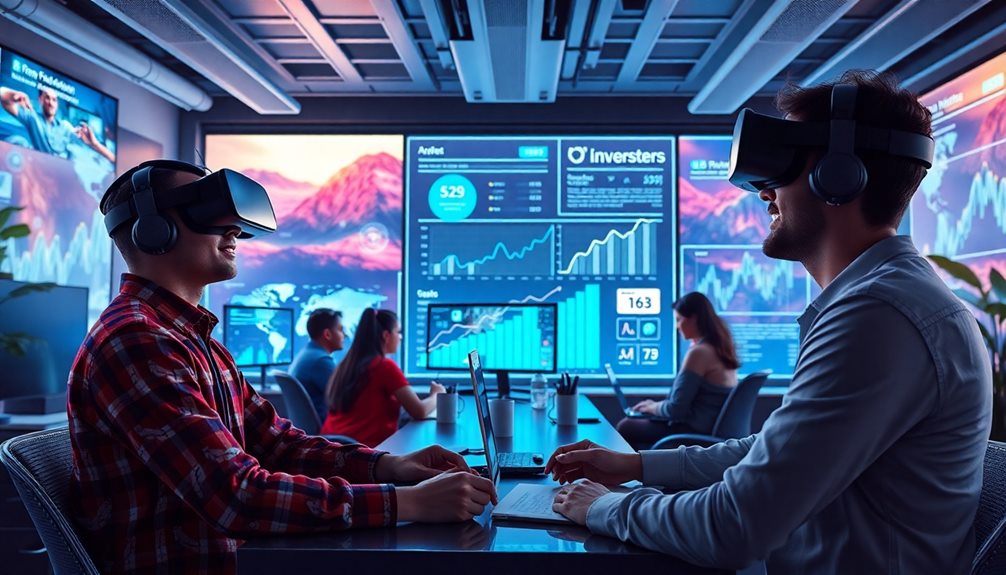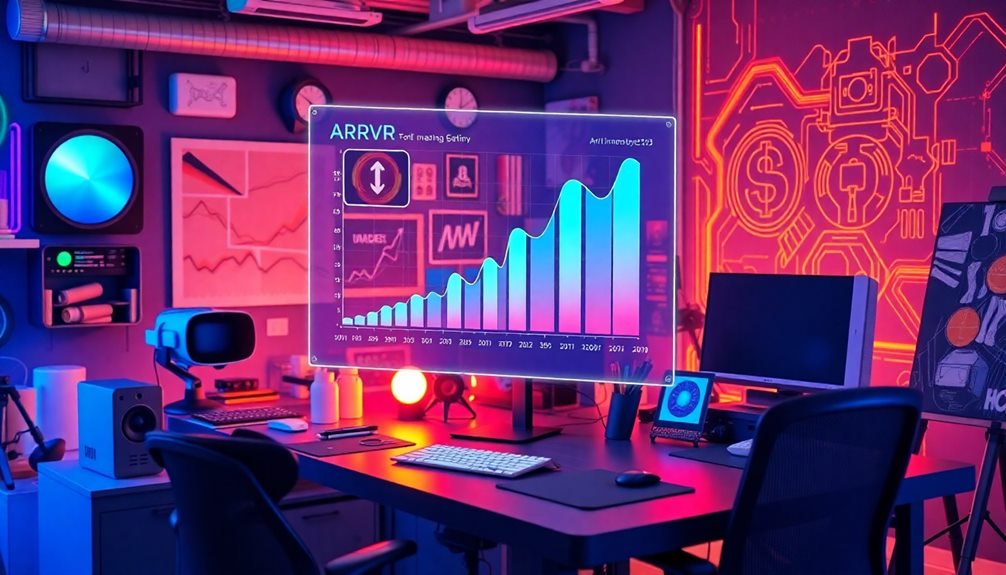AR/VR content creation is booming, with income potential soaring as the market is projected to surpass $20 billion by 2029. You'll find various revenue streams, including in-app purchases, advertising, and subscription models. The gaming sector especially thrives, accounting for over 70% of VR content consumption. North America leads the charge, but emerging markets in Asia-Pacific present exciting growth opportunities too. While challenges like high development costs exist, innovative technologies continue to drive demand. There's much more to explore about how you can take advantage of this expanding landscape and the opportunities it presents.
Key Takeaways
- The AR/VR content creation market is projected to grow significantly, reaching over $20 billion by 2029, creating income opportunities for creators.
- In-app purchases are expected to generate over $100 billion by 2025, with gaming being the primary revenue source.
- Advertising revenues from AR and VR are anticipated to reach $45 billion by 2029, providing lucrative income streams for developers.
- Subscription models in AR/VR are estimated at $1.5 billion in 2022, offering predictable income for content creators.
- High development costs and cybersecurity risks can pose challenges for income generation in AR/VR content creation.
Market Growth Projections

There's no denying that the AR/VR content creation market is on an impressive growth trajectory. You'll see projections indicating that the VR content creation market is set to skyrocket from USD 3.10 billion in 2024 to USD 20.54 billion by 2029, showcasing a staggering CAGR of 46.01%.
This growth is fueled by an increasing demand for immersive experiences across various sectors, particularly in the gaming industry. Additionally, as businesses leverage AI in Business to enhance user engagement, the potential for AR/VR content to provide personalized and interactive experiences becomes even more pronounced.
In fact, by 2028, VR revenue is expected to climb from $11.02 billion in 2023 to $19.75 billion, largely driven by enterprise spending and consumer engagement. The Asia-Pacific region stands out as the fastest-growing segment within this market, while North America continues to dominate regarding overall presence.
Market growth projections reveal not just a surge in revenue but also a fundamental shift in how content is being consumed and created. As sectors like education and healthcare also embrace VR, the potential for innovation and engagement expands considerably.
You have an opportunity to tap into this vibrant landscape as it evolves, making now the perfect time to explore the possibilities within the VR content creation market.
Key Revenue Streams

As you explore the key revenue streams in AR/VR content creation, you'll notice that in-app purchases are rapidly growing and becoming a significant income source.
Engaging storytelling is essential for enhancing user experience and encouraging more in-app purchases, as it creates deeper connections with the audience.
Advertising revenue is also emerging as a powerful player, especially with brands keen to tap into immersive marketing, which is similar to the trends seen in strategies for building a loyal podcast audience.
Plus, subscription models are gaining traction, offering creators steady income while keeping users engaged.
In-App Purchases Growth
In-app purchases are rapidly becoming a cornerstone of revenue generation in the AR and VR content creation landscape. By 2025, revenues from in-app purchases could exceed $100 billion, highlighting their importance in this evolving market.
The gaming segment drives this growth, accounting for over 70% of VR content consumption. This indicates a strong willingness among consumers to spend on virtual goods and enhancements, making in-app purchases a critical revenue stream for developers.
Additionally, as credit card debt in the U.S. continues to rise, consumers are increasingly looking for ways to enhance their experience while managing their finances. As more developers recognize this trend, approximately 36% are actively working on titles that will incorporate monetization through in-app purchases.
This shift not only caters to user demand but also enhances the overall gaming experience. Furthermore, the user base for AR and VR applications is projected to reach around 3.7 billion by 2029, amplifying opportunities for in-app purchases.
Additionally, AR advertising is emerging within this framework, where mobile ads and in-game purchases further drive engagement and revenue streams.
As you engage with immersive content, remember that in-app purchases not only enhance your experience but also play a significant role in shaping the financial landscape of AR and VR development.
Advertising Revenue Potential
With in-app purchases laying a solid foundation for revenue generation, advertising is stepping into the spotlight as another lucrative opportunity in the AR and VR landscape. The advertising revenue potential in immersive technology is massive, particularly as user engagement with augmented content continues to grow. Major tech companies recognize the market dynamics at play, investing heavily in AR and VR advertising to enhance brand engagement.
Here's a quick overview of the advertising revenue potential:
| Advertising Type | Projected Revenue (2029) | Key Platforms |
|---|---|---|
| AR Mobile Ads | $20 billion | Social Media |
| VR Interactive Ads | $15 billion | Gaming Platforms |
| Sponsored AR Experiences | $10 billion | Retail/Entertainment |
| In-App Ads | $5 billion | Mobile Apps |
With user penetration rates for AR applications set to hit 1 billion by 2023, brands are enthusiastic to tap into innovative marketing solutions. The expected revenue from interactive experiences will be a game-changer, so keep an eye on this evolving landscape.
Subscription Models Emergence
The rise of subscription models in AR and VR content creation is transforming how developers and users interact with immersive experiences. As these models gain traction, they provide a consistent revenue stream for content creators, allowing them to focus on enhancing user engagement through regular updates and new experiences.
Here are three key benefits of subscription models in this space:
- Recurring Revenue: Subscription services enable content creators to generate predictable income, fostering long-term sustainability.
- Diverse Content Access: Users gain easier access to a wide range of premium AR/VR experiences, with many willing to pay monthly fees for exclusive content.
- Enhanced Development Tools: Companies like Oculus and Unity offer developers valuable resources through subscriptions, improving the quality and scope of immersive content.
The global AR/VR subscription market is poised for significant growth, with 2022 revenues around $1.5 billion.
This highlights the potential for subscription models to reshape the industry and meet the increasing demand for varied content across gaming, education, and training applications.
Embracing these models can lead to richer user experiences and more engaged audiences.
Major Industry Players

Major industry players are driving the rapid evolution of VR content creation, with companies like Visualise Creative Limited, Panedia Pty Ltd, and Within leading the charge. These major players aren't just innovating; they're contributing considerably to the growth of the VR content creation market.
With increased investments, such as Vinci Games securing USD 5.1 million in April 2023 for VR game development, it's clear that the industry is gaining traction.
The VR landscape is becoming increasingly fragmented due to heightened competition, which encourages innovation and collaboration among various companies. For instance, BinaryX is planning to enter both the VR and AIGC markets with AI-based VR games, showcasing the diversification that's occurring in the industry.
Additionally, strategic partnerships, like the one between DPVR and FXG Video Science and Technology in 2022, are enhancing VR content platforms, indicating a trend towards collaborative efforts that benefit all players involved.
As these major players continue to adapt and evolve, you can expect considerable growth in the VR content creation market, driven by fresh ideas and new partnerships. The future looks promising for this dynamic industry.
Geographic Market Dynamics

There's a dynamic shift happening across geographic markets in the AR/VR content creation industry. North America currently leads the VR market, bolstered by technological advancements and a strong R&D presence in Silicon Valley.
This region's enterprise spending on VR content creation is projected to hit around $6.93 billion in 2023, highlighting significant investment in training and collaboration technologies.
On the other hand, the Asia Pacific is emerging as the fastest-growing market, driven by surging demand from the gaming industry.
With a projected CAGR of 45%, it's clear that this region is harnessing growth potential like no other.
Here are three key factors influencing these geographic dynamics:
- Investment Focus: North America leads with robust enterprise spending.
- Emerging Markets: Latin America and the Middle East are increasingly engaging in AR/VR, influenced by regional disparities.
- Sector-Specific Growth: Europe is witnessing strong AR/VR growth, especially in healthcare and automotive sectors.
As these markets evolve, understanding their unique dynamics will be essential for staying ahead in the AR/VR content creation landscape.
Trends in Content Creation

In the evolving landscape of AR/VR content creation, trends are rapidly reshaping how immersive experiences are developed and consumed. The VR content creation market is anticipated to skyrocket from USD 3.10 billion in 2024 to USD 20.54 billion by 2029, with a staggering CAGR of 46.01%. This growth is largely fueled by increasing demand for engaging and interactive experiences across various sectors.
Gaming content continues to lead the charge, with major developers heavily investing in VR game development. Currently, 36% of developers are working on titles for the Meta Quest VR headset, underscoring gaming's essential role in content creation.
Additionally, the rising technology adoption in enterprise settings, particularly for training and remote collaboration, highlights a shift towards practical applications of VR. This trend enhances communication and aids in visualizing 3D designs effectively.
Moreover, content types in the VR AR market, including 3D modeling, animation, and interactive storytelling, are becoming increasingly important. The COVID-19 pandemic has disrupted traditional dynamics but also opened new avenues for VR AR content creation, showcasing the sector's resilience and adaptability.
Embracing these trends will be vital for anyone looking to thrive in this vibrant market.
Consumer Demand Insights

Consumer enthusiasm for immersive experiences is driving the rapid growth of the VR content creation market.
With a projected increase from USD 3.10 billion in 2024 to USD 20.54 billion by 2029, the demand for engaging content is undeniable. This surge reflects a shift in consumer preferences, particularly in the area of VR gaming.
Here are three key insights into consumer demand:
- Game Development Investment: Major game developers are heavily investing in VR, with 36% currently focused on titles for the Meta Quest VR headset, showcasing a clear interest in VR gaming.
- Social Interactivity: Innovations like Virtex Stadium are transforming gaming by emphasizing community and interactive experiences. This trend indicates that consumers crave more than just a game; they want a shared experience.
- Enterprise Adoption: Businesses are adopting VR technologies for training and remote collaboration, driven by the demand for more effective and engaging methods.
Investment Opportunities

The rapid rise in demand for immersive VR experiences opens the door to exciting investment opportunities in the content creation market. The VR content creation market is projected to soar from USD 3.10 billion in 2024 to USD 20.54 billion by 2029, showcasing a remarkable CAGR of 46.01%. This growth signals a lucrative potential for investors ready to engage.
As major players like Visualise Creative Limited and Facebook seek partnerships, the competitive landscape is evolving. You can benefit from this by investing in innovative projects that align with the rising demand for VR. The surge in VR gaming and enterprise adoption for training and collaboration is creating substantial funding opportunities for both startups and established companies.
Moreover, the market is becoming fragmented, which means there's room for diverse content creators and technology developers. This fragmentation allows you to back various projects, increasing your chances of a rewarding return.
With venture funding rising—evidenced by Vinci Games securing USD 5.1 million for VR game development—it's clear that investor interest in the VR content creation landscape is strong. Don't miss your chance to be part of this booming sector.
Challenges and Barriers

Frequently encountered challenges can hinder the growth of the VR content creation market. As you explore this field, you'll face several barriers that can impact your success:
- High development costs: Creating immersive VR content requires significant investment in technology and talent. This financial barrier can limit entry for smaller companies and independent creators, reducing competition and innovation.
- Cybersecurity risks: With advanced computing technologies comes increased vulnerability. The reliance on extensive data collection raises concerns about data breaches and attacks, which can undermine user trust and deter adoption.
- Regulatory challenges: Managing privacy regulations surrounding user data collection in AR/VR experiences can complicate your market entry. These regulations not only increase compliance costs but can also deter potential consumers wary of privacy issues.
Moreover, the fragmentation of the market makes it difficult for you to gain visibility and effectively monetize your products. Increased competition creates noise, making it harder to stand out.
Overcoming these challenges is essential for anyone looking to thrive in the VR content creation landscape.
Technological Innovations

Technological innovations are transforming the VR content creation landscape at an unprecedented pace. The VR content creation market is projected to grow from USD 3.10 billion in 2024 to USD 20.54 billion by 2029, thanks to these advancements.
Major players like Meta and Sony are heavily investing in R&D, enhancing VR hardware capabilities with innovations such as mixed reality features in devices like the Quest 3.
As you immerse yourself in VR content development, the integration of AI in VR is becoming increasingly important. Companies like BinaryX are pioneering AI-based VR games, shifting the focus toward more interactive and intelligent experiences.
This is where advanced VR software comes into play, offering developers the tools needed to create immersive environments and high-quality 3D models efficiently.
Emerging technologies, including improved head-mounted displays (HMDs) and real-time rendering, are also elevating the visual and audio quality of VR content.
These enhancements lead to greater user engagement and satisfaction, making your work as a content creator even more impactful.
Future Outlook and Predictions

The future of AR and VR content creation looks incredibly promising, with market growth projections indicating a surge from $3.10 billion in 2024 to over $20 billion by 2029.
Emerging technologies will play a vital role in shaping this landscape, driving demand and innovation across various sectors.
As you navigate this evolving market, staying informed about these trends will be key to capitalizing on new opportunities.
Market Growth Projections
Amidst a rapidly evolving digital landscape, the AR/VR content creation market is set for remarkable growth.
With the VR content creation market projected to expand dramatically from USD 3.10 billion in 2024 to USD 20.54 billion by 2029, you can expect an impressive annual growth rate of 46.01%. This surge is fueled by an increasing demand for immersive experiences across various sectors.
Here are three key market growth projections to keep in mind:
- The global VR revenue is anticipated to rise from $11.02 billion in 2023 to $19.75 billion by 2028, showcasing a robust CAGR of 12.37%.
- The AR/VR content creation market, valued at US$ 385.5 million in 2018, is set to grow at a CAGR of 18.5% until 2026, indicating sustained interest and investment.
- The Asia-Pacific region is emerging as the fastest-growing market for VR content creation, while North America remains the largest, driven by significant investments and technological advancements.
As you navigate this burgeoning field, understanding these trends will be vital for positioning yourself effectively in the market.
Emerging Technologies Impact
As market growth projections indicate an exciting future for AR/VR content creation, emerging technologies are set to play a vital role in shaping this landscape. The global VR content creation market is projected to soar from USD 3.10 billion in 2024 to USD 20.54 billion by 2029, driven by advancements in immersive technologies.
Major players like Meta and Sony are heavily investing in VR technology, enhancing content creation capabilities and user engagement. You can expect a significant uptick in demand for VR within the gaming and entertainment industries, as well as for enterprise applications focused on remote collaboration and training.
With enterprise spending on VR projected to reach $6.93 billion in 2023, the potential for innovative content creation is vast. The Asia-Pacific region is emerging as a fast-growing market, while North America remains a stronghold.
However, as cybersecurity risks loom large, developing secure platforms will be essential for sustained growth in the content creation market. By leveraging these emerging technologies, you can position yourself at the forefront of this dynamic industry and capitalize on the opportunities ahead.
Frequently Asked Questions
How Much Does an AR VR Developer Make?
As an AR/VR developer, you can expect to earn between $60,000 and $150,000 annually, depending on your experience and location. The demand for skilled professionals in this rapidly growing industry continues to increase.
How Much Do VR Creators Make?
As a VR creator, your income can vary widely. Successful developers often make over $100,000 annually, depending on the demand for your content and collaborations with major players in the growing industry.
ARe AR VR Developers in Demand?
Like a rising tide lifting all boats, AR/VR developers are in high demand. Companies crave your skills to create immersive experiences. As technology advances, your expertise will become even more essential in this booming industry.
How Much Does It Cost to Create VR Content?
Creating VR content can cost anywhere from $10,000 to over $500,000, depending on complexity. You'll need to factor in expenses like software, hardware, salaries, and marketing to get a clear picture of your budget.
Conclusion
As the sun rises on the AR/VR content creation landscape, vast opportunities unfurl like petals in spring. You're poised to tap into a blooming market, where creativity meets technology, and innovation dances with possibility. Embrace the changing tides, and navigate the challenges with agility. By staying ahead of trends and investing wisely, you can carve your niche in this vibrant domain, turning dreams into immersive realities that captivate audiences and drive revenue. The future's yours to shape!









